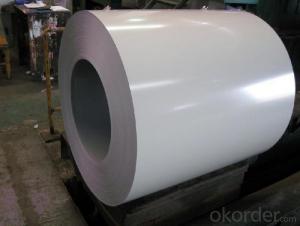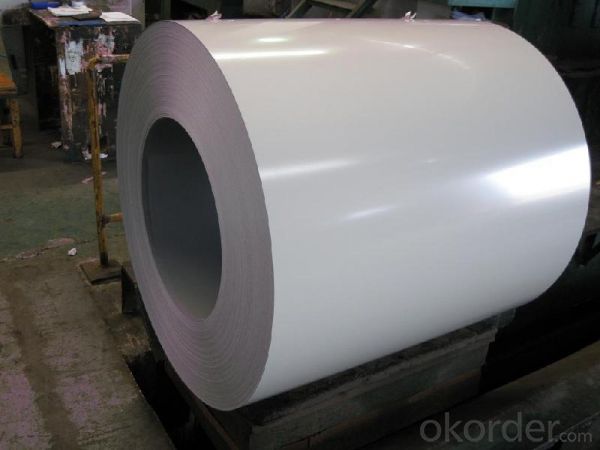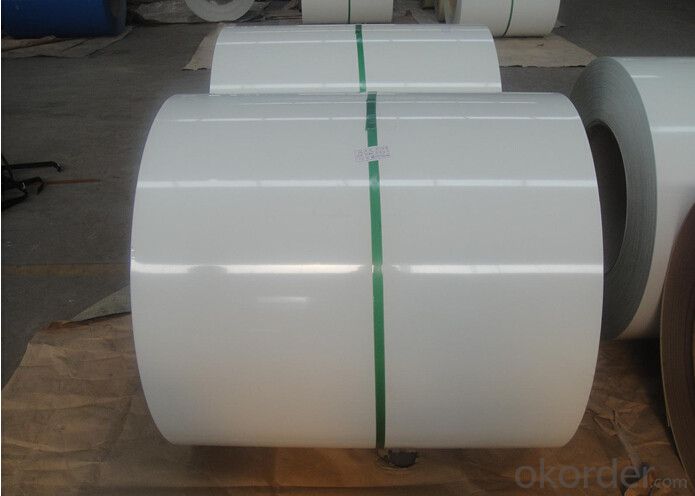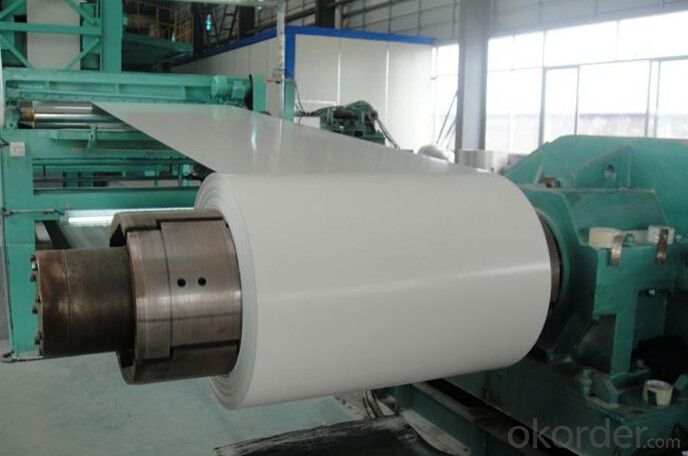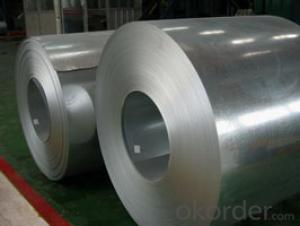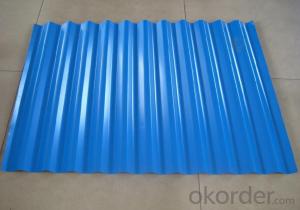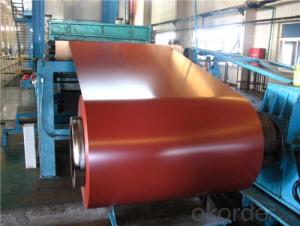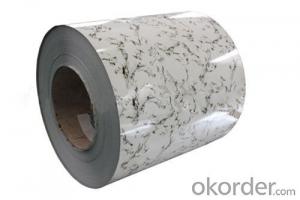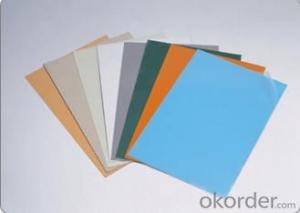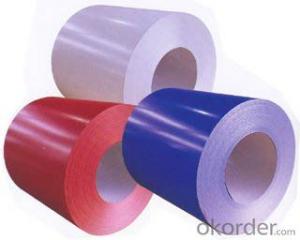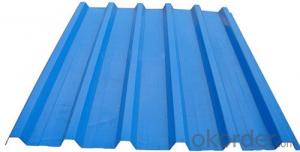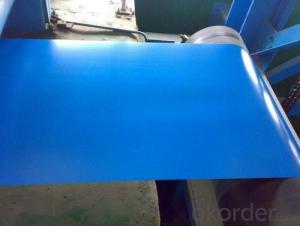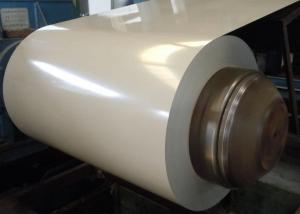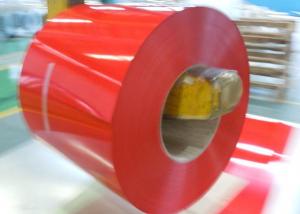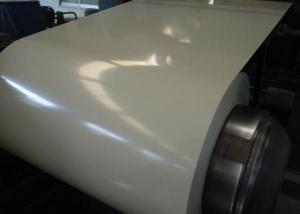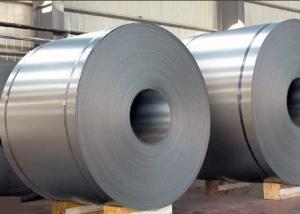Prepainted steel coils, hot-dipped Galvanized, RAL System, with good corrosion resistance
- Loading Port:
- Shanghai
- Payment Terms:
- TT OR LC
- Min Order Qty:
- 1 m.t.
- Supply Capability:
- 30000 m.t./month
OKorder Service Pledge
OKorder Financial Service
You Might Also Like
ppgl steel coil
Thickness: 0.15-0.6mm
Width:600-1250mm
Color:all Ral color
Hardness: Soft to full hard
Applications
1. Construction and building: roofing; ventilating duct; handrail; partition panel;etc.
2. Electric appliance: refrigerator; washing machine; refrigerator; DVD;etc.
3.Transportation: oil tank; road sign; etc.
4.Agriculture:barn; etc.
5.Others:vending machine; game machine; etc.
1.PPGL Steel information
Standard | ASTM A653, JIS G3302,GB/T3830-2006 |
Grade | DX51D,SGCC,SPCC,SGHC |
Thickness | 0.18mm--1.2mm |
Width | 400-1250mm(usual size:914mm,1000mm,1200mm,1219mm,1250mm,) |
Base metal | Galvanized steel coils, |
Zinc coating | 40-80gsm |
Coil ID | 508mm,610mm |
Coating thickness | Top:17-25um back:5-8um |
Color options | Ral number or as per your request |
Packing | Standard seaworthy export packing: 3 layers of packing, inside is kraft paper, water plastic film is in the middle and outside GI steel sheet to be covered by steel strips with lock, with inner coil sleeve. |
Delivery | Within 10-15days after signing contract |
Price | FOB&CNF&CIF price |
Payment terms | TT or L/C |
Monthly supply | 30000MT per month |
Application: | workshop, storeroom, roofing,kiosk... |
- Q: I want to know if it is possible to make regular steel stainless.From what I understand stainless consist of chromium about 10 percent I think.Any way I'm wondering if properties can be added in a process or can this only be possible during actual manufacturing of the steel.And I'm not talking about chrome like stainless steel that's not to shiny.
- no an alloy essentiallly does not exibit its constituent properties if you want to add anymore the thing should be molten and hot and homogenous homogenous being the key word and no ss essentiallly mean that thing only
- Q: How are steel coils used in the manufacturing of hydraulic cylinders?
- Steel coils are used in the manufacturing of hydraulic cylinders as they provide the necessary strength and durability required for the functioning of these cylinders. The coils are typically rolled and shaped into the desired cylindrical form, which serves as the outer body of the hydraulic cylinder. The steel coils are then further processed and assembled with other components to create a sealed chamber, where hydraulic fluid is pressurized to generate mechanical force. Overall, steel coils play a crucial role in ensuring the structural integrity and performance of hydraulic cylinders.
- Q: i am debating weather to get the hercules rmx or the steel and from what i have read, the only differences between them is the rmx has a sound card (built in interface-to connect to the computer, correct me if im wrong) and that the steel has more effects. however, i cannot find out which effects it has so it would be a big help if someone can answer this for me.thanx
- I guess that since Steel doesn’t have headphones connection and a built-in soundcard, one won’t be able to play a track on one deck and prelisten the track on the other without using an external usb soundcard, right? I was wondering what’s the point in releasing a product like this if you also have to buy a bunch of equipment to be able to do sth “fondamental”: play while preparing your next song. However since the steel is meant for DJ’s who already have a great soundcard, but I don’t see why a Steel+sound card is ONLY for pro’s. Yes it’s designed for pro’s but you can use it as a beginner. Some consoles you also need to consider: Hercules Steel/RMX, Numark OMNI/Steath. It's all personal decision. Peace, Love Happiness
- Q: Are steel buildings more durable than concrete building?
- Metal buildings are very cost-effective and costs less than a concrete or a wooden building. Steel prices are quite stable as compared to wood or concrete prices which are constantly rising.
- Q: How are steel coils used in the production of metal containers?
- Steel coils are widely used in the production of metal containers due to their versatility and strength. The process of manufacturing metal containers typically involves several steps, and steel coils play a crucial role in each of these stages. Firstly, steel coils are used as the primary raw material in the production of metal containers. The coils are made of high-quality steel that is rolled into a continuous sheet, ensuring consistent thickness and durability. This sheet is then cut into specific widths and lengths according to the size requirements of the containers. Once the steel coils are cut into the desired dimensions, they are formed into the shape of the container using various techniques. One common method is called roll forming, where the steel coil is passed through a series of roll dies that progressively shape it into the desired container shape. This can be done to create containers of various sizes and designs, such as cans, drums, or even large industrial containers. After the initial forming process, the steel coils are further processed to enhance their strength and durability. This can involve heat treatment, where the coils are exposed to high temperatures to increase their hardness and resistance to wear and tear. Other processes like annealing and quenching may also be utilized to improve the steel's properties. Once the containers are formed and processed, they undergo additional fabrication steps such as welding or sealing to ensure their structural integrity. Steel coils are often used in these processes as well, as they provide a strong and reliable material to create sturdy seams and joints. Finally, the metal containers are finished by applying various coatings or treatments to protect them from rust, corrosion, or other environmental factors. Steel coils can be coated with materials such as paint, epoxy, or zinc to enhance their resistance to these elements, ensuring the longevity of the containers. In summary, steel coils are essential components in the production of metal containers. From being the primary raw material to being used in forming, processing, and finishing, steel coils provide the strength, durability, and versatility necessary for the manufacturing of reliable metal containers for various industries.
- Q: Are you people aware of commercial steel warehouses, If yes then can you please explain their advantages and benefits?
- Steel okorder /
- Q: We bought a new fridge and the magnets don't stick to the front where the stainless steel is.
- not all types of stainless steel are attracted by magnets because of certain metals alloyed with the iron. here it is explained on wiki.
- Q: What are the different methods of surface inspection for steel coils?
- There are several different methods of surface inspection for steel coils, each with its own advantages and limitations. Some of the most commonly used methods include: 1. Visual Inspection: This is the simplest and most basic method, where an inspector visually examines the surface of the steel coils for any defects such as scratches, dents, or discoloration. While this method is subjective and dependent on the skill and experience of the inspector, it can be a cost-effective option for detecting obvious surface defects. 2. Magnetic Particle Inspection (MPI): This method involves applying a magnetic field to the steel coil and then applying iron particles on the surface. Any defects or cracks in the surface will disrupt the magnetic field, causing the particles to gather at those areas and making the defects visible. MPI is particularly useful for detecting surface cracks and defects that may not be easily visible to the naked eye. 3. Eddy Current Testing (ECT): ECT is a non-destructive testing method that uses electromagnetic induction to detect surface defects on steel coils. A probe with a coil is placed near the surface of the coil, generating an alternating magnetic field. Any changes in the electrical conductivity or magnetic permeability of the steel due to surface defects will cause a change in the induced current, which can be detected and analyzed. ECT is effective for detecting cracks, corrosion, or other surface irregularities. 4. Ultrasonic Testing (UT): This method uses high-frequency sound waves to inspect the surface and subsurface of steel coils. A transducer sends ultrasonic waves into the steel, and the reflected waves are analyzed to detect any changes or anomalies in the material. UT can identify defects such as cracks, delaminations, or voids within the coil, providing valuable information about the overall structural integrity of the steel. 5. Optical Inspection: This method utilizes advanced imaging techniques, such as cameras or laser scanners, to capture high-resolution images of the surface of steel coils. These images can be analyzed for defects, such as scratches, pits, or other irregularities. Optical inspection can provide detailed information and is often used in conjunction with other methods for a comprehensive inspection. It is important to note that each method has its own limitations and may be better suited for specific types of defects or surface conditions. Therefore, a combination of these methods is often employed to ensure a thorough and accurate inspection of steel coils.
- Q: How are steel coils used in the production of shelving units?
- Steel coils are used in the production of shelving units by being processed and formed into various components such as shelves, brackets, and support beams. These coils are typically cut, bent, and welded to create the necessary shapes and sizes required for the shelving unit. The steel material provides strength and durability to the shelves, ensuring they can hold heavy items and withstand the weight placed on them.
- Q: What website can I use to find a good picture that shows the atomic structure of a carbon steel?
- Carbon steel is a polycrystalline substance containing several compounds. Most of it is iron, but there are crystals of austenite and martensite present, plus other iron carbides. Each of these has a different atomic structure. The properties of the steel depend not so much on the atomic structures of the compounds, but more on the size and abundance of the crystals. The function of these crystals is to impede the movements of dislocations through the iron.
Send your message to us
Prepainted steel coils, hot-dipped Galvanized, RAL System, with good corrosion resistance
- Loading Port:
- Shanghai
- Payment Terms:
- TT OR LC
- Min Order Qty:
- 1 m.t.
- Supply Capability:
- 30000 m.t./month
OKorder Service Pledge
OKorder Financial Service
Similar products
Hot products
Hot Searches
Related keywords
